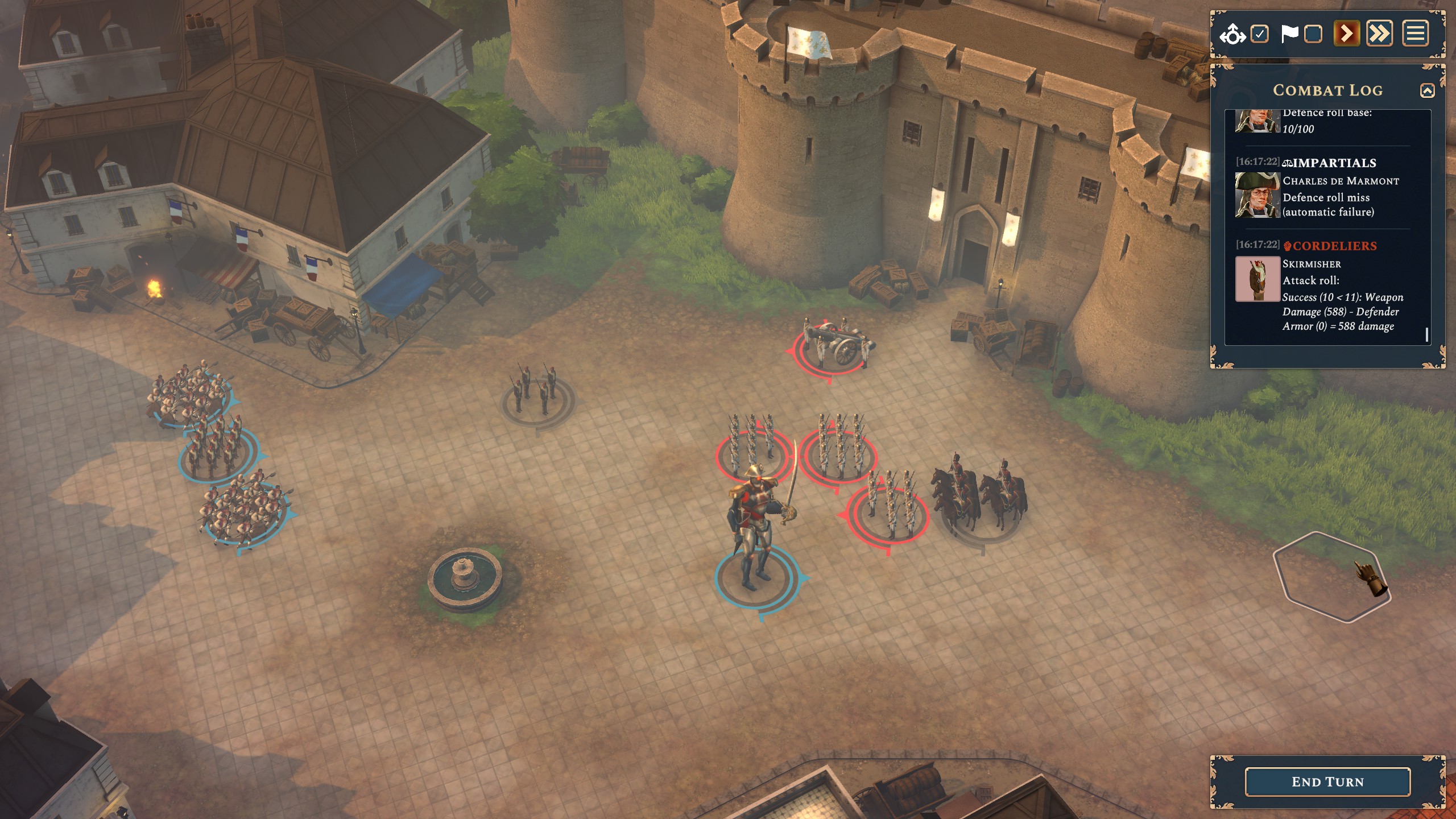

‘History but with mechs’ is hardly a new premise (see Iron Harvest, for example), and for upcoming tactics game Bonaparte: A Mechanized Revolution, it’s a pretty functional conceit: It lets the developers use big historical personalities as frontline warriors on a tactical grid without as much concern for their historical job, which was to stay a comfortable distance from flying bullets. The mechs are stand-ins for your hero characters, done and dusted.
Getting that out of the way is great for the overall gameplay because it lets Bonaparte focus on the big interesting personalities at work in the (alternate, yet very familiar) history here—and have their principled high-melodrama conversations about The Nature and Rights of Man or The Future of the French State on the battlefield from giant robots, rather than in dimly-lit conference rooms like in real life. (Presumably this is why Ridley Scott’s Napoleon movie didn’t do so well.) It also helps that your Bonaparte—Céline or César—is a blank slate you can characterize that only shares the loosest association with their historical counterpart.
After trying out a demo of the game, I can say that Bonaparte’s tactics are pretty straightforward stuff for fans of the genre: Simpler than something like XCOM or Fire Emblem, for example. Your units can move and attack each turn, or forgo that attack for a second move or use some special ability—like a cavalry charge or rallying when at low morale. The only real complication is that each unit has facing based on its last move or attack, either toward the left or right of the screen, and can’t automatically fight back if attacked from the other direction (“flanked”).
To win battles, then, you want to attack from their flanks as much as possible while preserving your own. So you’ll sometimes get neat Napoleonic-looking battle lines of troops, but eventually battles will collapse into chaotic positioning-based melees as you outfox the enemy. The complication there is your individual units’ morale, which can make them take more or less damage depending on how high or low it is.
The demo I played had a handful of unit types that each had clearly-defined roles—I’m not sure whether or not that will hold up over an entire campaign of battles, but I didn’t feel worn out on it by the end. At its most basic were the two infantry units, the Militia and the Line Infantry. Militia are armed with pikes, not guns, and are broadly weak—but, being made up of the people your regular soldiers are fighting for, can inspire higher morale in your troops. Your Line Infantry are the core of your army. They’re dense blocks of troops with high hit points and a two space range, best served by lining up and firing directly at the enemy in true Napoleonic fashion.
From there you have Skirmishers, whose rifles give them a 2-3 space range to harass Line Infantry without being fired back on. There are also Hussars, cavalry whose long movement and straight-line charge range let them get behind the enemy and deal devastating flanking attacks. And finally cannons, fragile, long ranged and very effective at devastating enemy morale—or taking down their mechs.
The last kind of unit you’ll use is the Colossus, the steam-and-phlogiston powered mechs that are piloted by your hero Leader characters. Colossi have huge hit point pools, but have to carefully manage how much heat they build up. One action per round is fine, but once you start attacking and firing their cannon-sized pistols they’ll take damage automatically as their heat rises, and can only vent it at a fixed speed. Your Colossi are a fire to be carefully used in bursts to knock out key enemies before they themselves burn out.
Battles show up because you’ve sent armies around France to capture territory, fight enemy factions, or undertake missions. I got a glimpse of this strategic layer and what I found was pretty interesting. Your Bonaparte can side with the radical Jacobin, moderate, and royalist factions of the revolution—promising three very different campaign stories of the proper revolution, a constitutional monarchy compromise, or a full-on siding with Louis XVI’s “L’État, c’est moi” attitude.
The territories can be controlled by each of the three factions, who can then develop them by spending money to make buildings or use the income for armies—much like a Total War game. At the same time the territories’ people have their own loyalties. The masses, the bourgeois, and the nobility each have loyalty to one of three revolutionary factions that you can spend your Leaders’ strategic actions to influence.
The Leaders themselves are recruited from your territories using an Influence resource, and include historical characters like Napoleon’s best bro Joachim Murat. Having those characters, each with their own statistics and loyalties to your cause or its allied philosophies, makes Bonaparte very interesting indeed. I think a lot of people would be really interested in the politics of playing factions against each other—Girondins, Montagnards, Bonapartists, and the like—in order to build their very own revolution-winning coalition. We’ll see if that promise delivers in 2025.



